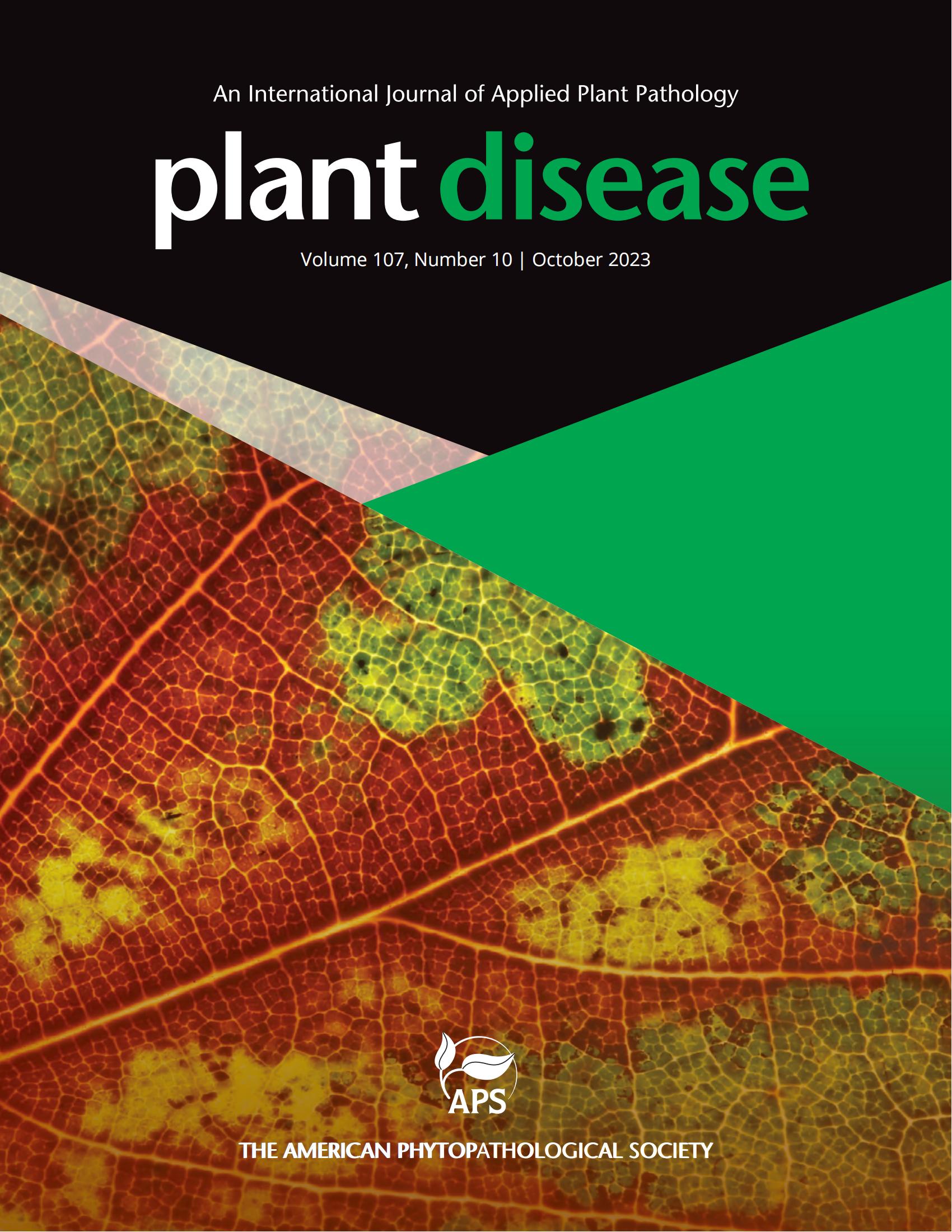在墨西哥首次报告了引起龙舌兰茎腐病的 Neocosmospora sp.
摘要
龙舌兰(Agave potatorum Zucc.)又名 "龙舌兰托巴拉",是墨西哥瓦哈卡州和普埃布拉州的特有物种,也是生产墨西哥蒸馏酒 "梅斯卡尔 "的最重要野生物种之一。2021 年 9 月,在墨西哥瓦哈卡州 Villa Sola de Vega 市的一块 10 英亩的商业田地里,发现了茎干干腐病的症状,随后植株死亡。发病率为 45%。对 20 株有症状的龙舌兰茎干进行了取样,以分离病原体。用 1%的 NaOCl(60 秒)和 70% 的乙醇(1 分钟)对病株的症状组织切片(5 × 5 毫米)进行表面消毒,用无菌水冲洗(2 × 60 秒),放在马铃薯葡萄糖琼脂(PDA Bioxon®,墨西哥)上,在 25°C 的自然光下培养 6 天。接下来,我们在 PDA 和康乃馨叶片琼脂(CLA)上制备单孢衍生培养物。在马铃薯葡萄糖琼脂(PDA)上持续分离出镰刀菌样菌落,并获得了 14 个单孢分离物。在 PDA 上,气生菌丝呈白色至米黄色,培养物中心有弥漫的粉红色色素,菌落在 25℃培养 7 天后呈规则的贴伏状。大锥体(n=100)呈镰刀形,几乎笔直,1 至 4 分裂, 18.5 至 47.9 × 3.9 至 5.7 μm。微孢子囊(n=100)呈椭圆形至近圆柱形,稍弯曲,透明, 8-16 × 3.5-4.5 μm,0-1室,呈假头状。衣孢子呈球形至近球形,顶生或夹生在菌丝中,单生或链生。形态特征与新孢子虫属的描述一致(Crous 等,2021 年;Sandoval-Denis 等,2019 年)。选取了三个分离株进行多焦点系统发育分析和致病性测试。分离物分别以 IPN-AP1、IPN-AP2 和 IPN-AP3 的名称保存在国立理工学院瓦哈卡植物病理学实验室(CIIDIR-Oaxaca)的植物病原真菌培养物中。为了进行分子鉴定,提取了基因组 DNA,并分别用引物组 EF1-728F/EF1-986R (Carbone 和 Kohn,1999 年)和 RBP2-5F/RPB2-7R (Liu 等,1999 年)扩增了翻译延伸因子 1-α(EF1-α)和 RNA 聚合酶 II 第二大亚基(rpb2)基因的部分序列并进行了测序。基于最大似然法,利用连接的 EF1-α 和 rpb2 序列构建了 Neocosmospora 属的系统发生树。系统发生分析表明,这三个分离株属于一个新物种,与 N. noneumartii 关系密切,因为它们与该物种形成了一个姐妹支系。序列已存入 GenBank,登录号为 OP902594 至 OP902594。EF1-α为 OP902594 至 OP902596,rpb2 为 OP902591 至 OP902593。每种分离物的致病性试验都是通过接种 5 株健康的盆栽 A. potatorum(1 年生)来进行的。分生孢子在 PDA 上培养 7 天,然后用无菌水配制分生孢子溶液,并调节至 1×105 孢子/毫升。在每株植物的基茎上放置 1 毫升分生孢子悬浮液。五株用无菌水模拟接种的植物作为对照。所有植物都在温度为 20 至 30°C 的温室中保存了 45 天。接种后 35 天,接种的植株出现茎干干腐病,而对照植株仍无症状。致病性试验重复了两次,结果相似。从受感染的植物中重新分离出真菌,发现其形态与用于接种的分离物相同,符合科赫假说。Neocosmospora spp.以前曾与南非柑橘的干根腐病(Guarnaccia 等人,2021 年)以及伊朗仙人掌科和其他多汁植物的腐烂病(Kamali-Sarvestani 等人,2022 年)有关。据我们所知,这是墨西哥乃至全球首次报道新孢子虫(Neocosmospora sp.进一步的研究应侧重于确定这种疾病在墨西哥龙舌兰产区的分布、影响和管理。Agave potatorum Zucc., also known as "agave tobalá", is an endemic species in the Mexican states of Oaxaca and Puebla and is one of the most important wild species for producing the Mexican alcoholic distillate called mezcal. In September 2021, symptoms of dry stem rot and subsequent death of plants were observed, in a commercial field of 10 acres located in the municipality of Villa Sola de Vega, Oaxaca, Mexico. The disease incidence was 45%. Twenty symptomatic agave stem plants were sampled to isolate the pathogen. Pieces (5 × 5 mm) of the symptomatic tissues from diseased plants were surface disinfested with 1% NaOCl (60 s) and 70% ethanol (1 min), rinsed with sterile water (2 × 60 s), placed on potato dextrose agar (PDA Bioxon®, Mexico), and incubated at 25°C for 6 days with natural light. Next, we prepared single-spore derived cultures on PDA and carnation leaf-piece agar (CLA). Fusarium-like colonies were consistently isolated on potato dextrose agar (PDA) and 14 monoconidial isolates were obtained. On PDA, aerial mycelium was white to beige with diffuse pink pigment in the center of the culture and colonies were appressed with a regular shape after 7 days of incubation at 25℃. Macroconidia (n=100) were falcate, almost straight, 1 to 4-septate, 18.5 to 47.9 × 3.9-5.7 μm. Microconidia (n=100) were ellipsoidal to subcylindrical, slightly curved, hyaline, 8 to 16 × 3.5 to 4.5 μm, 0 to 1-septate, and grouped in false heads. Chlamydospores were globose to subglobose, terminal or intercalary in hyphae, and were solitary or in chains. Morphological features were consistent with the description of Neocosmospora spp. (Crous et al. 2021; Sandoval-Denis et al. 2019). Three isolates were selected for multilocus phylogenetic analysis and pathogenicity tests. Isolates were deposited as IPN-AP1, IPN-AP2, and IPN-AP3 in the Culture Collection of Phytopathogenic Fungi of Plant Pathology Laboratory of the CIIDIR-Oaxaca of the Instituto Politécnico Nacional. For molecular identification, genomic DNA was extracted, and partial sequences of translation elongation factor 1-alpha (EF1-α) and the second largest subunit of RNA polymerase II (rpb2) genes were amplified and sequenced with the primer sets EF1-728F/EF1-986R (Carbone and Kohn 1999) and RBP2-5F/RPB2-7R (Liu et al. 1999), respectively. A phylogenetic tree using concatenated EF1-α and rpb2 sequences was constructed for Neocosmospora spp. based on Maximum Likelihood. The phylogenetic analysis suggested that the three isolates belong to a new species, closely related to N. noneumartii, as they formed a sister clade with this species. The sequences were deposited in GenBank with accession nos. OP902594 to OP902596 for EF1-α, and OP902591 to OP902593 for rpb2. A pathogenicity test for each isolate was performed by inoculating five healthy A. potatorum plants (1-year-old) grown in pots. Conidia were cultured on PDA for 7 days and the conidial solution was prepared with sterile water and adjusted to 1×105 spores/ml. A total of 1 ml of the conidial suspension was placed on the basal stem of each plant. Five plants mock-inoculated with sterilize water served as the controls. All plants were kept in a greenhouse for 45 days at temperatures ranging from 20 to 30°C. At 35 days after inoculation, dry stem rot was visible on the inoculated plants, whereas the control plants remained asymptomatic. The pathogenicity test was repeated twice with similar results. The fungi were reisolated from the infected plants and found to be morphologically identical to the isolates used for inoculation, fulfilling Koch's postulates. Neocosmospora spp., has been previously associated with dry root rot in Citrus sinensis in South Africa (Guarnaccia et al. 2021) as well as rot of Cactaceae and other succulent plants in Iran (Kamali-Sarvestani et al. 2022). To our knowledge, this is the first report of Neocosmospora sp. causing stem rot of A. potatorum in Mexico and worldwide. Further studies should focus on determining the distribution, impact, and management of this disease in the production areas of agave tobalá in Mexico.

 求助内容:
求助内容: 应助结果提醒方式:
应助结果提醒方式:


